3D printing is a process of producing real three-dimensional objects based on a project of digital file created in a CAD modeling software. 3D printers are used to create these objects. It is a device made of many components such as a head, extruder, stepper motors and a work table.
The construction of such devices also includes a large number of electrical and mechanical parts cooperating with each other. In this article, we will take a look at the most important components of a 3D printer and their functions.
Extruder

The most important component of the printer is the extruder. The extruder takes filament (the raw material from which 3D objects are printed) moving it through a gear driven by a stepper motor. The standard extruder has two ports – cold and hot. The filament is fed to the cold port in its original form before processing. The filament is guided by a gear drive driven by a stepper motor. On the other hand, through the hot port, the filament comes out in molten form and is fed to the printing area. The hot port connects to the outlet nozzle, where the final filament is formed under the outlet diameter of the nozzle. The whole extruder assembly is mounted on a frame, on which it can move in three dimensions, thanks to the stepper motors.

Head with nozzle
The thermoplastic material of the filament is melted in the head, where the temperature is high enough, supplied by the heating block. As a result, the material changes from solid to partially liquid. This enables the individual layers of the print to be arranged in a layer-by-layer manner. The extruder head and the filament thread coming out of it are additionally cooled by a fan. The thread diameter is much smaller than the original filament diameter before it is fed into the extruder.

Heated bed
The base on which the printed object is created is a table, which is designed to ensure the correct adhesion of the object to the substrate. Often, in order to ensure good adhesion, adhesive glue and pads are additionally used. An additional heating platform is often placed under the bed, which is especially needed when printing objects are made of filaments that show greater tendency to shrink.
Control unit and power supply
In order for the 3D printer to function, it must be connected to a power source. This is what the power supply does, most often with SMPS design with a closed feedback loop. Thanks to this, the 3D printing process is stable, even when the rated parameters of the mains voltage change significantly in real time. The power supply supplies voltage to the stepper motors, to the bed heater, as well as the 3D printer control unit. The 3D printer control unit is needed to control the stepper motors in real time, as well as the extruder and the head.


Thanks to this, we can choose printing parameters concerning, among others, print resolution and temperature of the heating block, according to the used nozzle and filament. The 3D printer controller usually comes with an LCD display, keypad, USB and Wi-Fi connectivity and micro SD memory card socket. This way, you can print your projects by loading files directly from the micro SD card or remotely from a computer that is connected to the same network as the printer. Moreover, open-source 3D printers can be modified with hardware and software from the target user level.
How useful was this post?
Click on a star to rate it!
Average rating 0 / 5. Vote count: 0
No votes so far! Be the first to rate this post.




